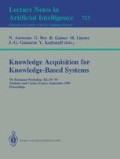Abstract
We propose a general approach that explicates the construction process of problem solving methods (PSMs) employed in knowledge-based systems. As akey point we employ the notion of a competence theory of a problem solving method. Illustrations are taken from the diagnostic Cover-and-Differentiate method used in MOLE and from various forms of abductive diagnosis. It is then shown how a rational construction of problem solving methods results from successive conceptual refinement and operationalization steps with respect to the competence theory. Our proposed Specification-Conceptualization-Operationalization method for PSMs provides top-down support for method construction, starting from an informal problem statement to an operational inference structure suitable for knowledge-based reasoning. Also, it gives some clues as to how PSMs have to be indexed or annotated in a library of generic and reusable components, in order to support ‘bottom-up’ or compositional modelling and design.
The research reported here was carried out in the course of the KADS-II project. This project is partially funded by the ESPRIT Programme of the Commission of the European Communities as project number 5248. The partners in this project are: Cap Gemini Innovation (F), Cap Programator (S), Netherlands Energy Research Foundation ECN (NL), Eritel SA (ESP), IBM France (F), Lloyd's Register (UK), Swedish Institute of Computer Science (S), Siemens AG (D), Touche Ross MC (UK), University of Amsterdam (NL) and Free University of Brussels (B).
This article expresses the opinions of the authors and not necessarily those of the consortium.
Preview
Unable to display preview. Download preview PDF.
References
J. McDermott. Preliminary steps towards a taxonomy of problem-solving methods. In S. Marcus, editor, Automating Knowledge Acquisition for Expert Systems, pages 225–255. Kluwer, Boston, 1988.
M. A. Musen. Automated Generation of Model-Based Knowledge-Acquisition Tools. Pitman, London, 1989. Research Notes in Artificial Intelligence.
L. Steels. Components of expertise. AI Magazine, 11(2): 28–49, Summer 1990.
G. Klinker, C. Bhola, G. Dallemagne, D. Marques, and J. McDermott. Usable and reusable programming constructs. Knowledge Acquisition, 3:117–136, 1991.
B. J. Wielinga, A. Th. Schreiber, and J. A. Breuker. KADS: A modelling approach to knowledge engineering. Knowledge Acquisition, 4(1): 5–53, 1992. Special issue ‘The KADS approach to knowledge engineering'.
B. Chandrasekaran. Generic tasks as building blocks for knowledge-based systems: The diagnosis and routine design examples. The Knowledge Engineering Review, 3(3): 183–210, 1988.
W. J. Clancey. Model construction operators. Artificial Intelligence, 53(1):1–115, 1992.
B. Chandrasekaran, T.R. Johnson and J.W. Smith. Task-structure analysis for knowledge modeling. Communications of the ACM, 35(9):124–137, 1992.
B. J. Wielinga, W. van de Velde, A. Th. Schreiber, and J. M. Akkermans. Towards a unification of knowledge modelling approaches. In Jean-Marc David, Jean-Paul Krivine, and Reid Simmons, editors, Second Generation Expert Systems. Springer-Verlag, 1993. To appear. Also as: Technical Report ESPRIT Project P5248, KADS-II/T1.1/TR/UvA/004/3.0 (1992).
A. Newell. The knowledge level. Artificial Intelligence, 18:87–127, 1982.
R. Reiter. A theory of diagnosis from first principles. Artificial Intelligence, 32:57–96, 1987.
D. L. Poole. Representing knowledge for logic-based diagnosis. In Proc. International Conference on Fifth Generation Computing Systems, pages 1282–1290, Tokyo, 1988.
L. Console and P. Torasso. Integrating models of the correct behaviour into abductive diagnosis. In L. C. Aiello, editor, Proceedings ECAI-90, pages 160–166, London, 1990. ECCAI, Pitman.
W. Van de Velde. Inference structure as a basis for problem solving. In Y. Kodratoff, editor, Proceedings of the 8th European Conference on Artificial Intelligence, pages 202–207, London, 1988. Pitman.
W. J. Clancey. Heuristic classification. Artificial Intelligence, 27:289–350, 1985.
B. J. Wielinga and J. A. Breuker. Models of expertise. In Proceedings ECAI-86, pages 306–318,1986.
L. Eshelman. MOLE: A knowledge-acquisition tool for cover-and-differentiate systems. In S. Marcus, editor, Automating Knowledge Acquisition for Expert Systems, pages 37–80. Kluwer, Boston, 1988.
A. Th. Schreiber, B. J. Wielinga, and J. M. Akkermans. Differentiating problem solving methods. In Th. Wetter, K-D. Althoff, J. Boose, B. Gaines, M. Linster, and F. Schmalhofer, editors, Current Developments in Knowledge Acquisition — EKAW'92, pages 95–111, Berlin, Germany, 1992. Springer-Verlag.
J. M. Akkermans, F. van Harmelen, A. Th. Schreiber, and B. J. Wielinga. A formalization of knowledge-level models for knowledge acquisition. International Journal of Intelligent Systems, 8: 169–208, 1993. Also in: K.M. Ford and J.M. Bradshaw, editors, Knowledge Acquisition as a Modeling Activity, pages 169–208, Wiley, New York, 1993.
F. van Harmelen and J. R. Balder. (ML)2: a formal language for KADS models of expertise. Knowledge Acquisition, 4(1): 127–161, 1992. Special issue: ‘The KADS approach to knowledge engineering'.
F. van Harmelen, J. M. Akkermans, B. Bartsch-Spörl, B. Bredeweg, C. H. Coulon, U. Drouven, W. Karbach, M. Reinders, A. Th. Schreiber, E. Vinkhuyzen, A. Voß, and B. J. Wielinga. Knowledge-level reflection: Specifications and architectures. ESPRIT Basic Research Action P3178 REFLECT, Deliverable R.2 RFL/UvA/III.2, REFLECT Consortium, 1992.
Author information
Authors and Affiliations
Editor information
Rights and permissions
Copyright information
© 1993 Springer-Verlag Berlin Heidelberg
About this paper
Cite this paper
Akkermans, H., Wielinga, B., Schreiber, G. (1993). Steps in constructing problem solving methods. In: Aussenac, N., Boy, G., Gaines, B., Linster, M., Ganascia, J.G., Kodratoff, Y. (eds) Knowledge Acquisition for Knowledge-Based Systems. EKAW 1993. Lecture Notes in Computer Science, vol 723. Springer, Berlin, Heidelberg. https://doi.org/10.1007/3-540-57253-8_47
Download citation
DOI: https://doi.org/10.1007/3-540-57253-8_47
Published:
Publisher Name: Springer, Berlin, Heidelberg
Print ISBN: 978-3-540-57253-4
Online ISBN: 978-3-540-47996-3
eBook Packages: Springer Book Archive

